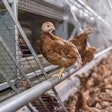This winter, health authorities and people living in countries of the WHO European Region located along wild birds’ migration routes should be particularly vigilant about avian influenza outbreaks in poultry and wild birds. Since some avian influenza viruses can infect humans, it is important that people in countries experiencing outbreaks take protective steps and avoid contact with sick and dead birds or contaminated environments.
Start of the autumn bird migration
In the European Region every autumn, wild birds migrate south-westwards to overwinter in warmer climates. Since June, the Russian Federation has experienced multiple avian influenza outbreaks in poultry along major bird migration routes. Given the presence of avian influenza viruses in the Region, their spread to other countries is likely.
Avian influenza outbreaks in the Russian Federation
Between mid-June and October 1, the Russian Federation reported 80 outbreaks of highly pathogenic avian influenza (HPAI) H5 virus and 1 outbreak of HPAI A(H5N2) virus among domestic poultry, to the World Organization for Animal Health (OIE). The Federal Service for Veterinary and Phytosanitary Surveillance of the Russian Federation has confirmed that the most recent outbreak was caused by a HPAI A(H5N8) virus. This virus is closely related to viruses that, in 2016–2017, caused the largest outbreak in poultry and wild birds ever recorded in the Region, resulting in millions of birds being culled and high economic losses. Migratory wild birds were identified as the likely vehicle bringing the virus to the Region. Therefore, vigilance of the public and close collaboration between the public health, veterinary and environmental authorities is important in the coming months to ensure rapid detection of avian influenza viruses in birds and to protect human health.
What should people do
A number of protective measures can be taken to prevent human infection with avian influenza viruses:
- Stay informed about wild birds’ migration routes in your country, as communicated by relevant national authorities.
- Avoid direct or close contact with any birds (poultry or wild birds) or contaminated environments and report sick or dead birds to responsible authorities.
- Do not touch birds or carcasses with bare hands. If you must handle a carcass, wear gloves or use an inverted plastic bag to collect the bird. Make sure you wash your hands with soap and water or use a suitable disinfectant after handling.
- Follow good food safety and food hygiene practices in line with WHO’s Five Keys to Safer Food Program; for instance, cook poultry or wild birds thoroughly at sufficiently high temperatures.
Avian influenza viruses and risk for human health
Human infection with avian influenza viruses is rare and is mostly linked to direct or close contact with live or dead infected birds or their environments. To date, no human infections with avian influenza A(H5N8) or A(H5N2) viruses have been reported. However, avian influenza viruses warrant close monitoring given their ability to change, potentially resulting in viruses that can pass from animals to humans. People in countries experiencing outbreaks are advised to adhere to the protective measures listed above.

















